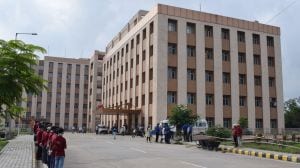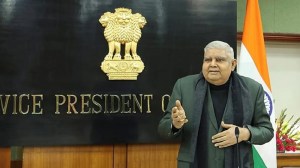Click here to join Express Pune WhatsApp channel and get a curated list of our stories
The case behind CJI Gavai’s first judgment, which proclaimed Pune land transfer as illegal
A Supreme Court bench comprising the CJI, Justice Augustine George Masih and Justice K Vinod Chandran concluded that the nexus between politicians, bureaucrats and builders had converted precious forest land into space for commercial use under the garb of resettling people
 Newly-appointed Chief Justice of India B R Gavai (Source: PTI)
Newly-appointed Chief Justice of India B R Gavai (Source: PTI)In a landmark judgment on May 15, also the first day after Justice B R Gavai took over as the Chief Justice of India (CJI), a Supreme Court bench comprising the CJI, Justice Augustine George Masih and Justice K Vinod Chandran concluded that the nexus between politicians, bureaucrats and builders had converted precious forest land into space for commercial use under the garb of resettling people.
What is the case and what is its connection with Pune?
An area measuring 32 acres and 35 guntha at Survey No. 20 of Kondhwa Budruk village in Pune was on March 1, 1879 notified as a reserved forest under the provisions of Section 34 of the Indian Forest Act, 1878. Thereafter, a portion of the land measuring 2 acres and 20 guntha was de-reserved by the state government on January 5, 1934 and the rest of the land remained as forest land.
In 1960, a different plot of land in Survey No. 37 of Kondhwa Budruk village owned by a family, the Chavans, was acquired by the state government to construct the Dr Bandorwala Leprosy hospital. The Chavan family was not paid any compensation and instead they requested the land in Survey No. 20 as an alternative for their resettlement and the tehsildar on May 13, 1968 released the land to the Chavan family for cultivation for one year on the condition that they will neither lease, mortgage, sell or excavate it without the approval of the Collector. The one-year contract was never renewed. However, the state government in 1969 decided that the forest land given on lease for cultivation should be permanently released for cultivation to the leaseholder after de-reservation.
Meanwhile, the Forest (Conservation) Act, 1980 came into force from October 25, 1980 and it stated that no forest land could be de-reserved or used for any non-forest purposes without the permission of the Union government. The Chavan family made an application to permanently release the land in 1988.
Bureaucracy’s action
On June 19, 1991, the then District Collector found that the members of the Chavan ‘family’ were using only 3 acres and 20 gunthas for cultivation. The Collector therefore recommended that the area under actual cultivation be allotted to them in view of the Government Resolution dated March 22, 1969 while recommending that the possession of the remaining land be handed over to the Forest department.
On November 30, 1994, the Divisional Commissioner recommended to the state government that the entire land should be allotted to the Chavan family and observed that there was no necessity to obtain the Union government’s prior approval for allotment of the land, which is a reserved forest.
Revenue minister’s intervention
The then state minister for revenue was of the opinion that the land was granted by the government for agricultural purposes and that the Chavan family was using the land continuously for the same purpose. Therefore, the provisions of the Forest Conservation Act 1980 were not applicable in the case. He, therefore, sought legal advice from the Law and Judiciary department of the Maharashtra government.
On July 27, 1998, the deputy secretary, Law and Judiciary department, gave his opinion that there was no necessity to obtain prior sanction of the Union government if the forest land was already broken up and acquired before the Forest Conservation Act 1980 came into force. Accordingly, the state revenue minister sanctioned the allotment of the land and the state government issued an order on August 4, 1998 to that effect.
On August 28, 1998, the District Collector issued a land allotment order subject to conditions that it will not be mortgaged, donated, sold, partitioned or exchanged, leased and bring the land into cultivation within a period of two years while clarifying the land can only be used for agriculture purpose.
The builder’s entry
On October 30, 1999, the Divisional Commissioner gave permission to the Chavan family to sell the land to the promoter of Richie Rich Cooperative Housing Society Ltd (RRCHS) to use it for the construction of private residences. It was revealed that the Chavan family had done transactions with promoters of the housing society on December 19, 1998 before they were given permission to sell.
On July 8, 2005, the District Collector gave permission to use the land for non-agricultural purposes, which is the construction of residential buildings. The Pune Municipal Corporation on February 27, 2006 issued a commencement certificate and sanctioned the building plan. On July 3, 2007, the Union environment and forest ministry gave environmental clearance for the construction of a residential, shopping and IT complex on the land.
Nagrik Chetna Manch challenges
In 2007, city-based NGO Nagrik Chetna Manch challenged the allotment of reserved forest land to private persons and its use to construct multi-storeyed buildings in violation of the Forest Conservation Act 1980. Thus, the court directed the Central Empowered Committee (CEC) to enquire and submit a report in the matter. The state revenue and forest department issued a notice on July 2, 2008 to the RRCHS and members of the Chavan family informing them about the state government’s decision to review its order of allotting the land to the “Chavan family”. It also served a notice to the RRCHS notifying the possession of the land would have to be taken back. Meanwhile, the RRCHS challenged the state government decision in the court.
CEC recommendations
On November 27, 2008, the CEC recommended the cancellation of allotment of 11.89 hectare of reserve forest land in Kondhwa Budruk for agriculture purposes and subsequent permission given for its sale in favour of the RRCHS and construction of buildings. It urged to restore the land back as a forest.
It also recommended prosecuting senior functionaries and officials of the Maharashtra government responsible for the allotment or use of the reserve forest land in violation of provisions of the Forest Conservation Act. These senior functionaries included the then state revenue minister who approved the land allotment; the then Pune Divisional Commissioner who granted permission for sale of the land in favour of a private person for the construction of buildings; the then deputy conservator of forests, Pune, who issued no objection certificate not only here but in many other cases, facilitating the illegal use of forest land for private gain; and the developer, who entered into various development agreements for the purchase and use of the land for construction of buildings.
It also recommended that a special investigation team (SIT) be constituted to examine the details of all reserve forest land under the control of the revenue department of Pune that had been allotted to be used without approval under the Forest Conservation Act. It recommended that all such allotments should be cancelled and those involved in such cases should be prosecuted for criminal breach of trust.
Documents forged
The RRCHS submitted a gazette notification dated March 9, 1944 to show that the land was not forest land and prayed for the proceedings to be disposed of. The state government said the gazette notification submitted in court was a fabricated document. Thus, the court ordered the CID on May 9, 2024 to inquire into it. On August 16, 2024 the CID submitted that the gazette document placed by the RRCHS was forged and not genuine.
Court verdict
The allotment of reserve forest land in Kondhwa Budruk for agriculture purposes and permission for its sale to the RRCHS was illegal, the SC ruled. The environment clearance by the Union environment and forest department was quashed. The land in possession of the revenue department should be handed over to the forest department within three months, the SC said. The chief secretaries of all states and administrators of all Union Territories have been directed to constitute SITs for examining as to whether any of the reserved forest land in possession of the revenue department has been allotted to any private individuals or institutions for any purpose other than forestry.
State governments and UTs have been directed to take steps to take back forested land from persons or institutions in possession of these plots and hand over the same to the forest department. If retrieving this land is not in larger public interest, state governments and UTs should recover the cost of the land from the persons or institutions to whom they were allotted and use the amount for development of forests.
Impact on Pune land
A small portion of the reserved forest land has been developed by the RRCHS. In this case, the SC has allowed for the cost of land to be recovered if possession is not possible. “The Supreme Court verdict might sound like forest area is protected, but in the case of Pune, the RRCHS has developed a section of the land, so it is likely the developed portion would exist by recovering land costs. This judgment has come after decades,” said civic activist Vijay Kumbhar.
Moreover, the court has not accepted the recommendation of the CEC completely and has not issued directions to prosecute all those who were involved in illegally converting forest land for residential purposes, he added.
Click here to join Express Pune WhatsApp channel and get a curated list of our stories













